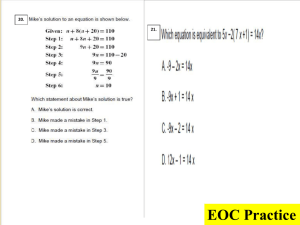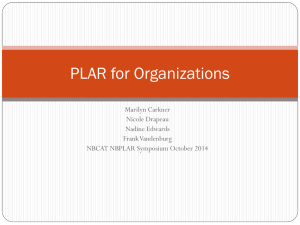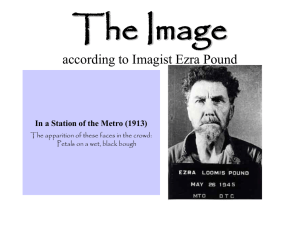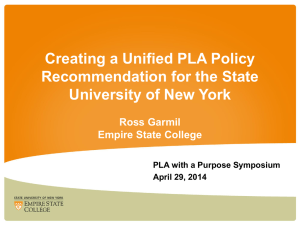ppt
advertisement
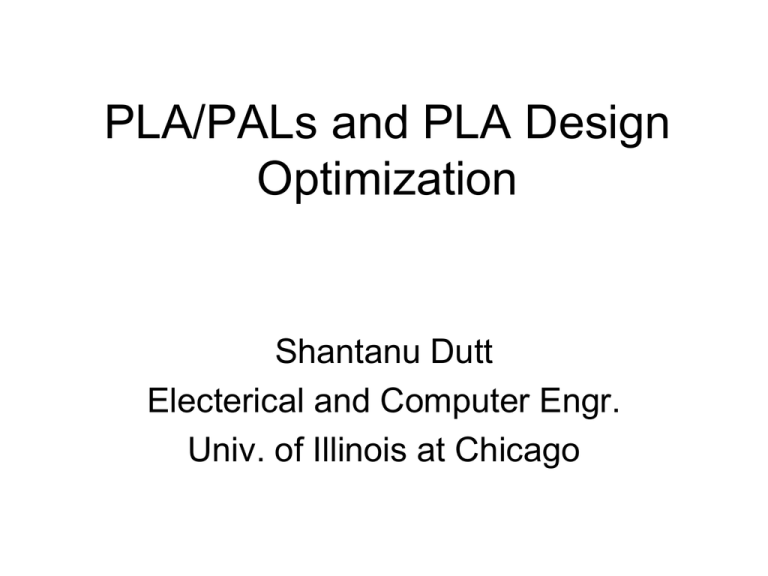
PLA/PALs and PLA Design
Optimization
Shantanu Dutt
Electerical and Computer Engr.
Univ. of Illinois at Chicago
Programmable Logic Arrays (PLAs) and
Programmable Array Logics (PALs)
Programmable
connections
Programmable
Non-programmable Programmable
In a PLA
In a PAL
Programmable
connections •
in PLAs
PLA/PAL advantages
• Ease in circuit implementation
(don’t have to worry about placing
and routing individual gates on a
chip)
• The wiring is well-patterned and
regular; thus easy to pre-estimate
delay and area costs of the
PLAs/PALs on a chip
• Disadvantage:
• Not CMOS, so higher power
consumption (esp. when o/p = 0)
A functional schematic; the implementation is more streamlined
PLAs and PALs (Contd)
A more streamlined
functional schematic:
PLAs (Contd)
Alternative notation (Hor top lines are literal and
bottom lines are OR lines; vertical lines are And lines)
PLAs: NOR-NOR Implementation
PLAs (Contd)
PLAs (Contd)
Programmable Array Logic (PALs)
Comments:
• More AND lines needed than called for by the
SOP expressions (and hence than in a PLA)
due to the static hardwired nature of the OR
plane
• A little faster than in the OR plane than PLAs
due to the pre-charging phase seeing only
one drain capacitance (of one nMOS) on each
OR line
PLAs with Feedback
• PLAs w/ feedback are, in
general, useful for implementing
“decomposed” circuits, in which
the internal o/ps of a subckt is
taken as a primary i/p of another
sub-circuit.
• Another way of looking at the
same thing is that PLAs w/
feedback can implement factored
non-SOP expressions.
• E.g. ab’(cd + de) + ce’(ac + bd’).
A0
B0
A1
B1
Feedback expressions
• A cost saving example: (ab’ + a’f + bf’)(cd +
d’e + c’e’).
• AND line cost of flat expression = 9 + slower
(each literal driving more AND line transistors:
max = 3).
• AND line cost of factored expr. using a pla w/
feedback: 3 + 3 + 1 = 7 + faster (each literal
drives fewer AND line transistors: max = 1).
• However, overall slower as 2 sets of AND-OR
delays are incurred due to feedback
C-1
C0
C1
S0
S1
•
QM for PLA/PAL Optimization
Hardware cost optimization for programmable
PLAs/PALs:
•
– PLA/PAL hardware cost in this case is only the total # of
PIs across all functions.
– The # of literals in a selected PI is of no consequence
•
as the PLA/PAL is designed so that each PI can have
up to the max # of literals, and using a PI w/ fewer
literals does not reduce PI cost—nMOS transistors
populate the entire (i.e., every location of the) ANDplane and OR-plane matrix for programmability, and
there is no issue of reducing their numbers. The # of PIs
across all functions is = # of AND lines in a PLA, and
smaller this #, smaller can be the PLA/PAL size (in
terms of # of AND lines).
– Thus PI cost should be 1 (each chosen PI 1 AND
line)
– In multifunction design (only for PLAs not for PALs):
• PI cost reduces from 1 to 0 after the PI becomes an EPI for
one function, since there will be no more AND lines reqd
for this PI if it is chosen for other functions.
• Also, each OR array can have the max # of AND terms (#
of AND lines = total # of chosen PIs) w/o any additional
cost (unlike in a gate based design where each additional
PI in a function an additional input for the 2nd level OR
gate).
• A multi-function PI can thus be chosen for each function for
which it is a PI (and for which it covers any MTs in the
current state of the PIT) once it becomes an EPI for any
function. Thus Rule 6 of multifunction QM not needed for
PLA cost minimization, and Rule 7 can be used w/o the
sweep-up phase. However, these rules are useful for delay
minimization in the OR plane (reducing the # of nMOS
gates driven by an AND line = degree of sharing of the PI).
Programmable PLA/PAL
hardware cost = total # of
AND lines = # of PIs in the
final expression.
Note: # of OR lines fixed
by # of funcs., so cost
optimization not an issue in
the OR plane
QM for PLA/PAL Optimization (contd.)
•
Hardware cost optimization for non-programmable PLAs:
– A non-programmable PLA is one in which the AND and OR array layouts are
similar to that of their programmable cousins, but nMOS transistors w/ their gate
connections hardwired to the needed literal line (in the AND array) or the AND line
in the OR array
– PLA hardware cost in this case could be: total literal cost (= total # of transistors in the
AND array) + total # of PIs across all functions (= # of AND lines corresponding transistors,
one per AND line, in the OR array) + S each PI PIj [degree of sharing of PIj] (= total trans’s. in OR
plane)
– Further, # of AND lines is more important to reduce than # of transistors in the
AND plane, as its affects the area of the PLA, while the # of transistors have a
much smaller impact on this). Thus we can assign a larger weight b > 1 to # of PIs
in the above expression to get the final cost of a non-programmable PLA to be:
total literal cost + b*(total # of PIs across all functions )+ S each PI PIj [degree of sharing of
PIj]
‒ Minimization of the above cost formulation in
QM/QM+ is achieved by setting PI cost = # of
literals in it + b (AND line cost) + 1. Thus in
multifunction design:
•
•
Multi-function PI cost reduces from above to 1
(for “extra” OR plane transistor cost if chosen
later for other functions) after it becomes an EPI
for one function, since the AND plane transistor
cost + AND line cost for this PI has been
incurred and will not be incurred further if
chosen later for other functions. reqd for this PI
if it is chosen for other functions
Thus either Rule 6 or Rule 7 followed by the
sweep-up phase is needed in cost minimization
of a (multi-function) non-programmable PLA.
PLA/PAL Delay
• Assume charge & discharge times on a line
: Charging path
: Discharge path
D2
D3
D1
are approx. the same.
• Charge/Discharge time on a line i
= Rd * (CLi+CW)
where Rd is driver/sink (for chrg/disch, resp)
transistor resistance, CLi is the total transistor
gate cap on i, and CW is the wire cap on i.
We ignore drain/source cap as that is much
smaller. We also ignore wire res. here.
• From the PLA circuit opt. point of view, Rd
and CW are constants. Thus we can minimize
delay in this design phase by minimizing the
max # of transistor (gate) connections across
all lines (which minimizes maxi{CLi} on each
relevant set of lines: literal and AND lines.
• For the literal line (delay D1) this means
min. the max # of PIs a literal belongs to
• For the AND line (del. D2) this means min.
the max # functions they belong to (i.e., the
degree of sharing—this is one example of the
conflict betw delay and h/w cost.
• For the OR line (del. D3) there are no trans.
gate connections, and drain/src connections
are fixed and the same for all lines. Thus
there is no delay optimization for this line.
• PLA Delay = delay of literal line + delay of AND line + delay of OR line = D1 +D2 + D3
• Critical path delay in PLA = max all interconn 1,2,3 lines (D1 +D2 + D3) <= max D1+max D2+max D3
Delay optimization (Initial Cost Formulation):
QM for PLA Hardware (H/W) + Delay Opt.
•
PLA delay = max(delay from any input literal to an o/p)
•
Each literal signal incurs a delay (D1) that is proportional to the # of
transistors it drives. It is thus important to balance the # of
transistors driven by each literal min(max # of chosen PIs that
each literal is in)
•
Each PI signal’s delay on the AND line (D2) is also similarly
proportional to the # of transistors in the OR array that it drives (i.e.,
on the # of functions it belongs to). So this delay can be minimized
by min(max # of functions each PI is in). ). However, PI sharing is
useful for cost min. so we ignore this aspect of delay here. (Can
we augment QM to consider extra delay on AND line when PI is
shared, and tradeoff delay w/ cost as we do below for literal lines?)
•
But either Rule 6 or Rule 7 followed by the sweep-up phase should
be used to reduce unnecessary sharing, as the latter can increase
the PI signal’s delay.
•
Thus for combined h/w & delay (D1 only) min., start w/ a PI cost = 1
(for h/w cost; this will min # of AND lines). After a PI g is chosen,
increase the cost of each PI h by w if g and h share at least 1
Ex: f(A,B,C,D) = S m(1,3,5,7,9) + S d(2,6,12,13)
common literal that currently is in the largest # of chosen PIs so far.
MSBs
AB
Otherwise, there is no increase in g’s cost.
CD
00
01
11
10
•
This is done, since such literals in g will drive an additional
4
12 x
8
transistor gate if g is subsequently chosen, thus increasing the D1
00 0
delay. It is should thus be “expensive” to choose a PI such as g.
LSBs
5 1 13 x 9 1
01 1 1
•
w is the ``norm. weight’’ of the importance of delay compared to
hardware cost (AND lines). E.g., w = 0.2 we can sacrifice delay
CD
3 1
7 1 15
11
by up to (1/0.2)*a = 5a units in order to save 1 AND line, where a
11
<= 1 is the estimated fraction of the contribution of D1 to the total
AD
6 x
14
10
PLA/PAL delay. On the other hand, w = 2 we can sacrifice a
10 2 x
AC
delay increase of up to (1/2)*a = 0.5a units to save 1 AND line or
conversely, we can sacrifice up to 1 AND line to not incur a delay • cost(C’D) = 1 + 0.2 = cost(A’D) = cost(A’C) (w =
0.2)
increase of 0.5a units.
•
C’D is an EPI choose it cost(A’D) incr. to
•
The covering rule can be applied taking this cost into consideration
1.2 + 0.2 (due to common literal D driving max
trans. [1] so far) = 1.4
(e.g., for two PIs that cover each other, delete the higher-cost one,
•
A’C good covers A’D, A’D bad covers A’C
and by not deleting a lower-cost covered PI—either PI-pair based
delete A’D A’C is a p-EPI choose A’C
covering or least cost/MTs based heur. can be used to break such
•
Final soln: f = C’D + A’C has a smaller delay in a
a “pseudo-cyclic” or “deadlocked” table)
PLA than the alternate soln. of C’D + A’D
Delay optimization (Initial Cost Formulation):
QM for PLA Hardware (H/W) + Delay Opt.
•
PLA delay = max(delay from any input literal to an o/p)
•
Each literal signal incurs a delay (D1) that is proportional to the # of
transistors it drives. It is thus important to balance the # of
transistors driven by each literal min(max # of chosen PIs that
each literal is in)
•
Each PI signal’s delay on the AND line (D2) is also similarly
proportional to the # of transistors in the OR array that it drives (i.e.,
on the # of functions it belongs to). So this delay can be minimized
by min(max # of functions each PI is in). However, PI sharing is
useful for cost min. so we ignore this aspect of delay here. (Can
we augment QM to consider extra delay on AND line when PI is
shared, and tradeoff delay w/ cost as we do below for literal lines?)
•
But either Rule 6 or Rule 7 followed by the sweep-up phase should
be used to reduce unnecessary sharing, as the latter can increase
the PI signal’s delay.
•
Thus for combined h/w & delay (D1 only) min., start w/ a PI cost = 1
(for h/w cost; this will min # of AND lines). After a PI g is chosen,
Advanced Considerations—Not in Syllabus:
increase the cost of each PI h by w if g and h share at least 1
• An alternate cost is to have the cost grow
common literal that currently is in the largest # of chosen PIs so far. slowly as opposed to being binary w/ a sharp
Otherwise, there is no increase in g’s cost.
step (go from 0 to 1 as soon as a literal goes
•
This is done, since such literals in g will drive an additional
from being in max-1 to max # of PIs so far).
transistor gate if g is subsequently chosen, thus increasing the D1 • So when PI g is selected, for every PI h that g
delay. It is should thus be “expensive” to choose a PI such as g.
has common literal(s) with, determine among
•
w is the ``norm. weight’’ of the importance of delay compared to
these literals, the max. # k of chosen PIs they
hardware cost (AND lines). E.g., w = 0.2 we can sacrifice delay occur in
by up to (1/0.2)*a = 5a units in order to save 1 AND line, where a • E.g., incr. cost by w*(e/(e-1))*(1-e-(k/kmax) ))
<= 1 is the estimated fraction of the contribution of D1 to the total OR w(e-(1-[k/kmax]) )) OR w*k/kmax, where kmax
PLA/PAL delay. On the other hand, w = 2 we can sacrifice a
is the globally max. # of chosen PIs that a
delay increase of up to (1/2)*a = 0.5a units to save 1 AND line or literal (a critical literal) is currently present in.
conversely, we can sacrifice up to 1 AND line to not incur a delay • This allows us to “anticipate” and consider
increase of 0.5a units.
costs of literals that can get critical in the near•
The covering rule can be applied taking this cost into consideration future in the QM opt. process.
(e.g., for two PIs that cover each other, delete the higher-cost one, • But this does not do “look-ahead” (check
and by not deleting a lower-cost covered PI—either PI-pair based what PIs are remaining and for each literal
covering or least cost/MTs based heur. can be used to break such estimate how many it belongs to will be
a “pseudo-cyclic” table)
chosen. What is a good look-ahead estimate?
